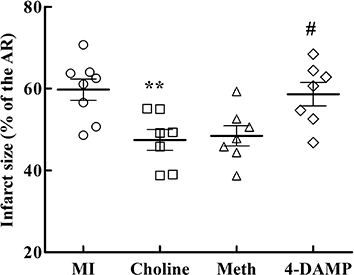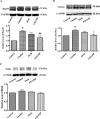Activation of cardiac muscarinic M3 receptors induces delayed cardioprotection by preserving phosphorylated connexin43 and up-regulating cyclooxygenase-2 expression
- PMID: 20128816
- PMCID: PMC2848926
- DOI: 10.1111/j.1476-5381.2009.00606.x
Activation of cardiac muscarinic M3 receptors induces delayed cardioprotection by preserving phosphorylated connexin43 and up-regulating cyclooxygenase-2 expression
Abstract
Background and purpose: Activation of muscarinic M(3) mucarinic acetylcholine receptors (M(3)-mAChRs) has been previously shown to confer short-term cardioprotection against ischaemic injuries. However, it is not known whether activation of these receptors can provide delayed cardioprotection. Consequently, the present study was undertaken to investigate whether stimulation of M(3)-mAChRs can induce delayed preconditioning in rats, and to characterize the potential mechanism.
Experimental approach: Rats were pretreated (24 h), respectively, with M(3)-mAChRs agonist choline, M(3)-mAChRs antagonist 4-DAMP or M(2)-mAChRs antagonist methoctramine followed by the administration of choline. This was followed by 30 min of ischaemia and then 3 h of reperfusion. Ischaemia-induced arrhythmias and ischaemia-reperfusion (I/R)-induced infarction were determined. The phosphorylation status of connexin43 (Cx43) after 30 min ischaemia, and the expression level of Hsp70, cyclooxygenase-2 (COX-2) and iNOS effected by administration of choline were also measured.
Key results: Compared to the control group, pretreatment with choline significantly decreased ischaemia-induced arrhythmias, reduced the total number of ventricular premature beats, the duration of ventricular tachycardia episodes and markedly reduced I/R-induced infarct size. Furthermore, choline attenuated ischaemia-induced dephosphorylation of Cx43, and up-regulated the expression of Hsp70 and COX-2. Administration of 4-DAMP abolished these changes, while methoctramine had no effect.
Conclusions and implications: Our results suggest that stimulation of M(3)-mAChRs with choline elicits delayed preconditioning, which we propose is the result of up-regulation of the expression of COX-2 and inhibition of the ischaemia-induced dephosphorylation of Cx43. Therefore, M(3)-mAChRs represent a promising target for rendering cardiomyocytes tolerant to ischaemic injury.
Figures





Similar articles
-
Activation of cardiac M3 muscarinic acetylcholine receptors has cardioprotective effects against ischaemia-induced arrhythmias.Clin Exp Pharmacol Physiol. 2012 Apr;39(4):343-9. doi: 10.1111/j.1440-1681.2012.05672.x. Clin Exp Pharmacol Physiol. 2012. PMID: 22224440
-
Glucagon-like peptide-1 (GLP-1) mediates cardioprotection by remote ischaemic conditioning.Cardiovasc Res. 2016 Dec;112(3):669-676. doi: 10.1093/cvr/cvw216. Epub 2016 Oct 4. Cardiovasc Res. 2016. PMID: 27702763 Free PMC article.
-
PPAR-alpha activation as a preconditioning-like intervention in rats in vivo confers myocardial protection against acute ischaemia-reperfusion injury: involvement of PI3K-Akt.Can J Physiol Pharmacol. 2012 Aug;90(8):1135-44. doi: 10.1139/y2012-052. Epub 2012 Jul 18. Can J Physiol Pharmacol. 2012. PMID: 22809038
-
Choline produces cytoprotective effects against ischemic myocardial injuries: evidence for the role of cardiac m3 subtype muscarinic acetylcholine receptors.Cell Physiol Biochem. 2005;16(4-6):163-74. doi: 10.1159/000089842. Cell Physiol Biochem. 2005. PMID: 16301817
-
Protection of the ischaemic heart: investigations into the phenomenon of ischaemic preconditioning.Cardiovasc J Afr. 2009 Jan-Feb;20(1):43-51. Cardiovasc J Afr. 2009. PMID: 19287816 Free PMC article. Review.
Cited by
-
The association between RGS4 and choline in cardiac fibrosis.Cell Commun Signal. 2021 Apr 23;19(1):46. doi: 10.1186/s12964-020-00682-y. Cell Commun Signal. 2021. PMID: 33892733 Free PMC article.
-
Muscarinic Receptors in Cardioprotection and Vascular Tone Regulation.Physiol Res. 2024 Apr 18;73(Suppl 1):S389-S400. doi: 10.33549/physiolres.935270. Epub 2024 Apr 18. Physiol Res. 2024. PMID: 38634650 Free PMC article. Review.
-
Hindlimb unloading results in increased predisposition to cardiac arrhythmias and alters left ventricular connexin 43 expression.Am J Physiol Regul Integr Comp Physiol. 2013 Mar 1;304(5):R362-73. doi: 10.1152/ajpregu.00391.2012. Epub 2013 Jan 9. Am J Physiol Regul Integr Comp Physiol. 2013. PMID: 23302960 Free PMC article.
-
Choline inhibits angiotensin II-induced cardiac hypertrophy by intracellular calcium signal and p38 MAPK pathway.Naunyn Schmiedebergs Arch Pharmacol. 2012 Aug;385(8):823-31. doi: 10.1007/s00210-012-0740-4. Epub 2012 May 9. Naunyn Schmiedebergs Arch Pharmacol. 2012. PMID: 22569796
-
Cardiac resynchronization therapy restores sympathovagal balance in the failing heart by differential remodeling of cholinergic signaling.Circ Res. 2015 May 8;116(10):1691-9. doi: 10.1161/CIRCRESAHA.116.305268. Epub 2015 Mar 2. Circ Res. 2015. PMID: 25733594 Free PMC article.
References
-
- Beardslee MA, Lerner DL, Tadros PN, Laing JG, Beyer EC, Yamada KA, et al. Dephosphorylation and intracellular redistribution of ventricular connexin43 during electrical uncoupling induced by ischemia. Circ Res. 2000;87:656–662. - PubMed
-
- Bolli R. The late phase of preconditioning. Circ Res. 2000;87:972–983. - PubMed
-
- Budd DC, McDonald J, Emsley N, Cain K, Tobin AB. The C-terminal tail of the M3-muscarinic receptor possesses anti-apoptotic properties. J Biol Chem. 2003;278:19565–19573. - PubMed
-
- Cascio WE, Yang H, Muller-Borer BJ, Johnson TA. Ischemia-induced arrhythmia: the role of connexins, gap junctions, and attendant changes in impulse propagation. J Electrocardiol. 2005;38(4) Suppl.:55–59. - PubMed
Publication types
MeSH terms
Substances
LinkOut - more resources
Full Text Sources
Research Materials

